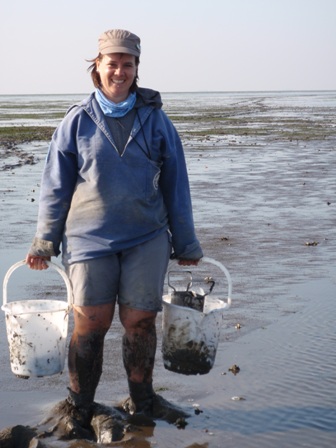Die Inhalte dieser Seite sind leider nicht auf Deutsch verfügbar.
Seitenpfad:
- INTERCOAST
- Latest News
- Archiv
- News 2010
- Dorothea Kohlmeier reports on her field work on the Island Sylt
Dorothea Kohlmeier reports on her field work on the Island Sylt

As a baseline study I assessed photosynthesis of different seagrass meadows around the Wadden Sea island Sylt. The work was conducted this summer at the Wadden Sea Station of the Alfred-Wegener-Institute which provided me with lab space and logistics. The most abundant native marine macrophytes in the Wadden Sea are the seagrasses Zostera marina (Eelgrass) and Zostera noltii (Dwarf Eelgrass). While Z. noltii is growing intertidally Z. marina is considered an intertidal and subtidal species. Seagrass beds are ecologically especially relevant because they provide a habitat to other organisms, like juvenile fish. Due to the so-called wasting disease in the 1930’s the subtidal populations nearly all got extinct.
Besides collecting samples for determinations of light response curves via oxygen evolution measurements in the lab, I also conducted measurements in the field over the course of a whole day in order to detect changes in photosynthetic properties. Light conditions are changing drastically in diurnal and tidal cycles. While seagrass submerged in the morning might experience low light conditions, emersion during noon leads to high light conditions and even photoinhibitory light levels. Parameters measured are optimum and effective quantum yield (via PAM-Fluorometry). Pigment samples were taken for analysis of photosynthetic vs. protective pigment content. Additionally, temperature and light were measured continuously.
The research stay at the Wadden Sea Station was very stimulating for me and gave me also the possibility to join a course on Network Analysis which dealt with the analysis of food webs. Fieldwork was sometimes challenging (sink into mud up to your knees, start working at 3 o’clock in the night), but to snorkel in a submerged seagrass meadow is a special experience and helps to understand the complexity of this habitat.
Besides collecting samples for determinations of light response curves via oxygen evolution measurements in the lab, I also conducted measurements in the field over the course of a whole day in order to detect changes in photosynthetic properties. Light conditions are changing drastically in diurnal and tidal cycles. While seagrass submerged in the morning might experience low light conditions, emersion during noon leads to high light conditions and even photoinhibitory light levels. Parameters measured are optimum and effective quantum yield (via PAM-Fluorometry). Pigment samples were taken for analysis of photosynthetic vs. protective pigment content. Additionally, temperature and light were measured continuously.
The research stay at the Wadden Sea Station was very stimulating for me and gave me also the possibility to join a course on Network Analysis which dealt with the analysis of food webs. Fieldwork was sometimes challenging (sink into mud up to your knees, start working at 3 o’clock in the night), but to snorkel in a submerged seagrass meadow is a special experience and helps to understand the complexity of this habitat.


